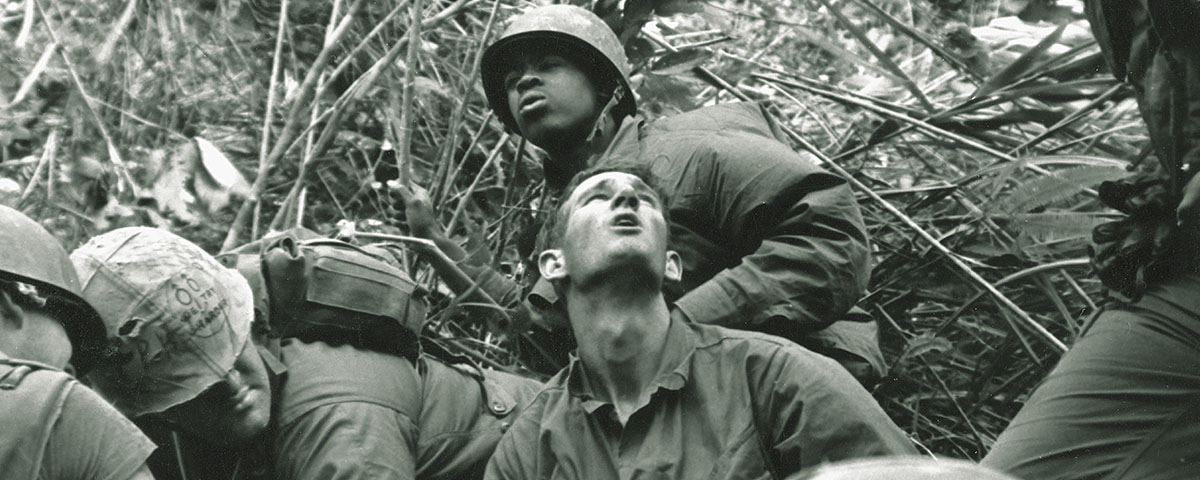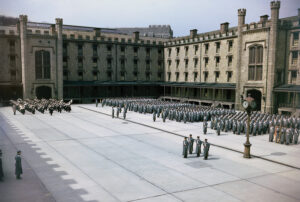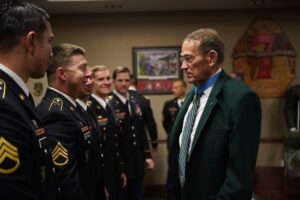In February 1968, eight Marines volunteered for a suicide mission
After 32 casualties during the first 30 hours of Operation Pursuit, initiated in mid-February 1968 by the 1st Marine Division to search for enemy rocket caches in the mountains west of Da Nang, Lt. Col. Bill Davis ordered Charlie and Delta companies of the 1st Battalion, 7th Marine Regiment, to get off Hills 270 and 310 and return to their base camps in the flatlands to the east.
A little later that morning of Feb. 16, the acting commander of Charlie Company, 1st Lt. Dana F. MacCormack, whose men were descending from Hill 270, radioed Davis: “Here come the NVA, colonel! I’ve got one more KIA that the last helo did not have room for. We are having a hell of a time carrying this body, and the bones are cutting up the body bag.” Davis, on Hill 310 with the battalion command group, told MacCormack to get Charlie Company off the mountain immediately to avoid any more casualties. And that meant leaving the body behind.
Thousands of North Vietnamese Army troops had trekked down the Ho Chi Minh Trail in eastern Laos and moved through South Vietnam’s A Shau Valley before making their way to high ground, including Hills 270 and 310, overlooking an area known as Happy Valley and the Marine positions to the east.
Units from the 31st NVA Regiment and the 368B Artillery Regiment operated frequently out of Happy Valley before moving into the “Rocket Belt,” an arc running north to south around the western side of Da Nang at the ideal range for NVA forces firing Soviet-made 122 mm and 140 mm rockets at Da Nang Air Base, Marble Mountain Air Facility and vital ammunition dumps and fuel depots. The inner edge of arc’s belt was about 5 miles from the Da Nang installations; the outer edge of the belt was about 7½ miles away. If NVA rocket squads were outside that belt on the western side, their rockets would likely fall short. But if they were too close to Da Nang on the inner side of the belt, they might overshoot their targets.
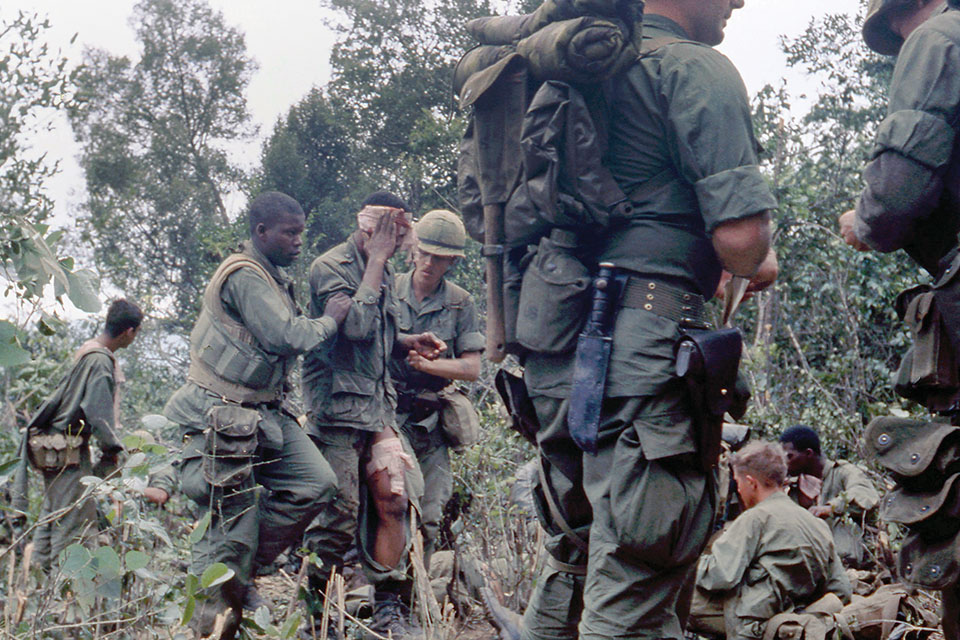
Each battalion of the 7th Marines was responsible for a section of the belt, making sure no enemy rockets got inside the arc and within firing range. The 1st Battalion’s headquarters was on Hill 10, inside the belt. Its 72-square-mile area of responsibility extended westward toward the high ground that included Hills 270 and 310, about 3 miles from Hill 10 (the designations reflected hill elevations in meters).
On Feb. 13, the day before the start of Operation Pursuit, Davis met with Col. Paul Graham, the 1st Marine Division operations officer. A few days earlier, a large secondary explosion was observed on the saddle-shaped area connecting Hills 270 and 310. The explosion indicated the presence of NVA rocket caches, and Graham relayed an order from the division commander, Maj. Gen. Donn J. Robertson, to conduct a search of that area—one of the toughest jungle/mountain terrains in the battalion’s assigned territory.
Operation Pursuit began at 11 a.m. on Feb. 14 as Charlie Company crossed the western end of Hill 10 while Delta Company departed from Hill 41, about 2 miles to the southeast. Accompanying them were 1st Division combat correspondent Sgt. Robert Bayer and photographer Cpl. R.J. Del Vecchio.
The two companies linked up on the approach to Hills 270 and 310. The dense jungle growth at the base of Hill 270 channeled the Marines into a single-file column during the slow, exhausting climb that forced the men to hack out a trail with machetes. By 6:30 p.m., Delta Company had secured Objective 1, the saddle between Hills 270 and 310. Charlie Company had secured Objective 2, the top of Hill 270.
The commander of Charlie’s 2nd Platoon, 2nd Lt. Mark Whittier, later wrote a letter to his wife describing evidence of the enemy that this men discovered: “We got to the top of Hill 270 and found a bunker and communication system that the [NVA] had been using. Also we uncovered a log that we translated. This bunker had a perfect view of the entire Da Nang area and the diary had accounts of when units left our hill and where they were going….The last entry in the diary was that ‘there were beaucoup Marines leaving Hill 10 for this position.’” The bunker had been vacated in haste, and the radio was still on.
Charlie Company used the bunker as an overnight command post and blew it up the next morning, Feb. 15. Around that same time, an enemy ambush wounded four Marines of Delta Company in the saddle area. Charlie Company, with Whittier’s platoon in the lead, moved quickly down the south side of Hill 270 to reinforce the ambushed Delta squad.
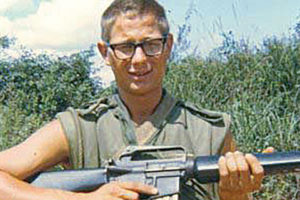
Suddenly, Whittier’s point squad, which had reached the saddle, was also ambushed by NVA soldiers concealed in bunkers and “spider holes,” foxholes hidden underneath a camouflaged lid. Three Charlie Marines were killed immediately, and several were wounded.
Pfc. Michael J. Kelly, a member of the point squad who had been with the company for only two months, was hit by an enemy bullet that struck a grenade on his cartridge belt. The detonation killed Kelly, severing a leg in the process.
The point squad’s machine gun team leader, Lance Cpl. Russell Naugle, ran down the trail toward one of the wounded Marines while firing his M60 machine gun from the hip. As the corporal pulled his comrade to safety, he was wounded four times. Naugle died later that day from his wounds and posthumously received the Silver Star.
Medevac helicopters flew in to evacuate the casualties, but the side of Hill 310 above the saddle was covered with such dense jungle undergrowth that the choppers had to lower extraction harnesses for the pickups, often while under fire from NVA rocket-propelled grenades, AK-47 assault rifles and 12.7 mm machine guns. Finally, after five hours of battle and medevac efforts, Charlie Company got out all its casualties except Kelly. When the day ended, Charlie and Delta companies had suffered five killed and 27 wounded.
The next day, Feb. 16, around 7:30 a.m., after Davis issued the order for Charlie and Delta companies to return to their base camps, his 1st Battalion command group and Delta Company were preparing to move down to the valley floor when Charlie Company commander MacCormack radioed. The lieutenant reported that his men, still in the saddle area, were taking gunfire from bunkers concealed in thick vegetation above them on the north side of Hill 310. Six NVA soldiers were firing at them—so close that MacCormack’s Marines could make out their uniforms, flak jackets and helmets.
A Marine reconnaissance team to the west, on Hill 502, advised Davis that a large NVA force was headed toward the Charlie Marines. The colonel alerted MacCormack, who soon announced that he could see the NVA coming and added that his men were having “a hell of a time” carrying Kelly’s body.
As the company continued its descent, MacCormack again radioed Davis: “I’ve got five WIA being helped down Hill 270, which is slowing us down, so I had to leave our KIA [Kelly] in a bomb crater on the saddle. We can come back out and get his body later.”
In early afternoon, out of food and water and low on ammunition, the weary, battle-shocked Marines of Charlie Company arrived at Hill 10 and were met by the actual company commander, Capt. Karl Ripplemeyer, who had been on leave and just returned. Delta Company, meanwhile, had reached its base camp on Hill 41.
Davis radioed the regimental commander, Col. Ross R. Miner, and told him that the Marines were back at the command posts, but added that a dead Marine had to be left behind. A few hours later, Miner told Davis that a B-52 bombing mission was scheduled to strike Hills 270 and 310 and ordered him to send a team to recover Kelly’s body before the bombing started. Davis, however, did not want to risk any more lives in those mountains before the bombing runs were completed and argued against an immediate recovery mission, but Miner wouldn’t rescind his order.
Davis discussed Miner’s order with Ripplemeyer, as well as the battalion operations officer and the officer who coordinated air support for the battalion. Davis decided to use Charlie Company volunteers for the recovery since they knew the location of Kelly’s body.
“It was 100% a suicide mission,” Whittier, the 2nd Platoon lieutenant, would write to his wife on Feb. 17. “This is a point I can’t too heavily emphasize.”
“Suicide mission” was an unintentionally appropriate term, given Charlie Company’s longstanding nickname: “Suicide Charley.” The unit had earned its nickname during the October 1942 Japanese assault on Guadalcanal, when 1st Battalion was led by Lt. Col. Lewis B. “Chesty” Puller, who later became the Corps’ most decorated Marine and finished his career as a lieutenant general. During that battle, Charlie Company held its line against a far larger Japanese force despite suffering heavy losses. The day after the fight, a white flag of parachute cloth with a picture of a skull and crossbones rose over the company’s position. Emblazoned on the flag was “Suicide Charley.”
The patrol to recover Kelly’s body had only a few hours to prepare for its departure. A runner was sent to Charlie Company seeking the volunteers, including an experienced squad leader. John D. McCreless, then a 20-year-old sergeant, recalled: “When the decision came down to use a squad of volunteers, I got crazy and raised my hand and said I’d lead it.”
Lance Cpl. Stephen B. McCashin responded similarly: “When I heard they were asking for volunteers, I said anyone who would go back into those mountains again would have to be crazy. I thought it was a suicide mission, but since I’m on my second tour here, I must be crazy, so I decided to go.”
Pfc. Joseph A. Hamrick signed up because, he said, “I was the only one of the volunteers who knew exactly where the body was, so even though I had only been in the ‘Nam’ for a month and had never walked point, I figured I could go right to it.”
The other Marines on the eight-man patrol were Pfc. Thomas M. Adamson, Lance Cpl. Tyree Albert Chamberlain, Pfc. Alfred P. Granados, Cpl. Billy R. Ranes and Pfc. Pedro A. Rodriguez. Someone—no one can remember exactly who—dubbed the volunteers the “Doom Patrol.”
Granados, the radio operator, remembers their preparations. “Our equipment was light for a short recon patrol—no helmets, flak jackets or cartridge belts, and all but one of the men of the Doom Patrol asked to trade their M16s for the more reliable M14, and permission was granted,” he said. “We were to make no enemy contact, travel by stealth in the dark, get the body and return. If we ran into a superior enemy force, we were to abort, split up and get back any way we could.”
Before the men departed, a senior staff sergeant told McCreless: “None of you will probably return alive, but to increase your chances, if things get hairy you can just bring back the leg.” The eight Marines weren’t totally on their own for the mission. The battalion air officer had arranged for continuous air support for the patrol.
At 2 a.m. on Feb. 17, McCreless’ squad left Hill 10. A little more than an hour later, near the abandoned village of Phuoc Ninh (5)—military maps distinguished villages with the same name by numbering them—the Marines spotted NVA soldiers moving toward their position. Chamberlain opened fire and killed one of them, but the patrol was now compromised. McCreless faced a difficult decision: abort the mission or stay the course. He spoke to the battalion command center and was told to proceed. No one wanted an empty casket sent to Kelly’s family, and the men on the mission knew the odds when they volunteered.
On the move again toward the base of Hill 270, the Marines observed another enemy patrol, and McCreless stopped for an hour near another abandoned village, Phuoc Ninh (7), a precautionary pause in the dark to make sure there was no other NVA activity in the area before continuing their journey.
By sunrise, around 5 a.m., the patrol had cleared the open rice paddy areas and started into the dense jungle on the side of the mountain—with a long march still ahead, which meant they would have to conduct their “stealth” mission in broad daylight. Three hours later, the men were in a flat area above the bomb crater where Kelly’s body lay, covered with a poncho. There they waited while pilots in O1-Bird Dog propeller-driven planes called in airstrikes.
One of the pilots radioed McCreless to tell him that napalm drops by F-4 Phantom II fighter-bombers would land just forward of the bomb crater. He instructed the patrol members to take cover, take three deep breaths, exhale and hold their next breath. The napalm struck about a 100 yards in front of the patrol. Granados still remembers the intense heat and dust being sucked past his face into the inferno. The shock waves from the blast seemed to raise him off the ground.
After the napalm flames diminished, Granados saw NVA soldiers emerging from bunkers and spider holes. McCreless, worried that the enemy troops were about to move against his seriously outnumbered men, yelled: “Get the leg, and let’s get the hell out!”
Moments later, Ranes and Adamson dashed to the crater. They grabbed the severed leg and quickly strapped it to a backpack that Chamberlain carried. The eight Marines then ran back down the trail, amid the still-smoldering napalm and the enemy fire tearing into trees and brush around them. A final strafing run by F-4 Phantoms silenced the firing.
After reaching the flatlands, the patrol came upon Charlie Company’s 1st Platoon, sent to assist the squad if any of the men had been wounded or killed. The platoon escorted McCreless’ squad to base camp, and by 2 p.m. all the Marines were back on Hill 10.
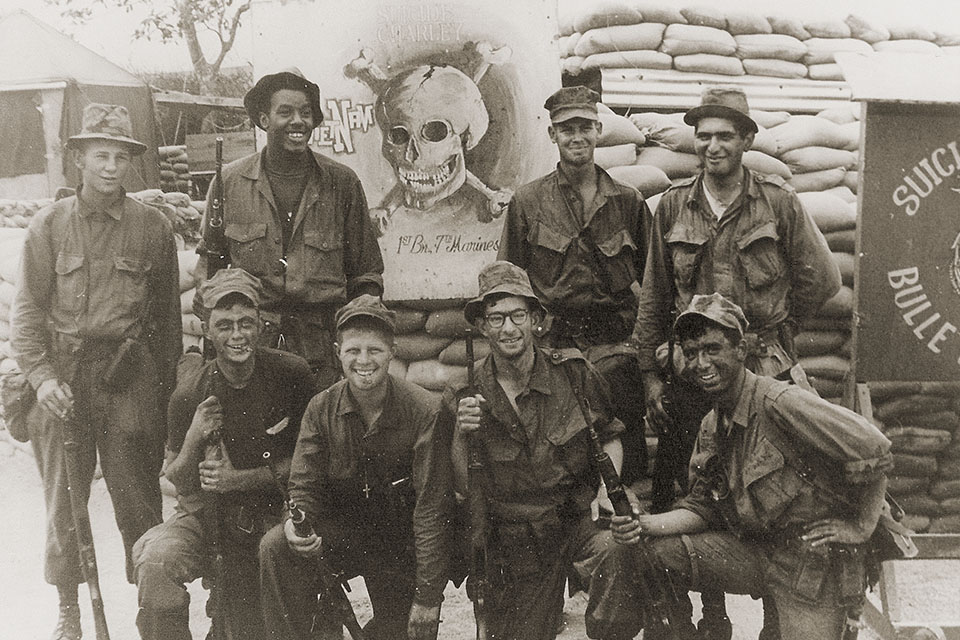
Amid great rejoicing, Davis summoned the men to his quarters and handed them cigars and cold beer to celebrate their incredible accomplishment. (He wasn’t aware at that time that the full body had not been recovered.) As recounted in his autobiography Tet Marine, Davis told the Doom Patrol that he had been a fan of Suicide Charley since the Chosin Reservoir battle during the Korean War. “I’ve been proud of them during all these years, because they did great things at the Reservoir,” he said. “But never did they do anything greater than YOU did, as volunteers, last night and today.”
McCreless said: “The only reason I can think of why we were able to pull it off is that the NVA just couldn’t believe that we were stupid enough to go in there and do what we did. They must have thought we were bait for some kind of trap.”
After the celebration, Davis typed a letter to the commander of the 7th Marine Regiment:
“Dear Colonel Miner, I’ve never been prouder to be a Marine than at this moment! This magnificent squad [from Suicide Charley] went on what appeared to be a suicide mission. I wish you could have heard this young Marine [Pfc. Joseph Hamrick] describe why he volunteered. He just couldn’t imagine that an empty casket would go to a Marine’s parents. He knew they had to do the job, and while he was scared all the way out, and all the way back, he knew that they just had to succeed. I’ve just lived through an experience that I’ll always hold dear to me. Semper Fi.”
Within 10 hours of the patrol’s return, the B-52s from Andersen Air Force Base on Guam devastated the high ground on Hills 270 and 310. But the NVA would return to Hill 310, and many more Marines were wounded or killed there the following month during Operation Worth and in August during Operation Mameluke Thrust.
On March 8, Whittier and McCreless were wounded. Later that day, at the Navy hospital in Da Nang, Whittier died from his wounds. A few days later, McCreless was medevaced to Japan for additional surgery. During fighting on May 30, Doom Patrol volunteer Rodriguez was killed.
Men from E Company, 2nd Battalion, 7th Marines, found Kelly’s body on March 25 during Operation Worth. A medevac helicopter picked up the remains and took them to the mortuary in Da Nang. A funeral with a casket containing Kelly’s leg was held in his hometown of Findlay, Ohio, in March 1968. A second funeral, with the rest of his remains, was held in April 1968. ✯
—Jack Wells served in Vietnam during 1968-69 as an artillery forward observer with Alpha and Bravo companies, 1st Battalion, 7th Marine Regiment, 1st Marine Division, and later as executive officer of H Battery, 3rd Battalion, 11th Marine Regiment, 1st Marine Division.

